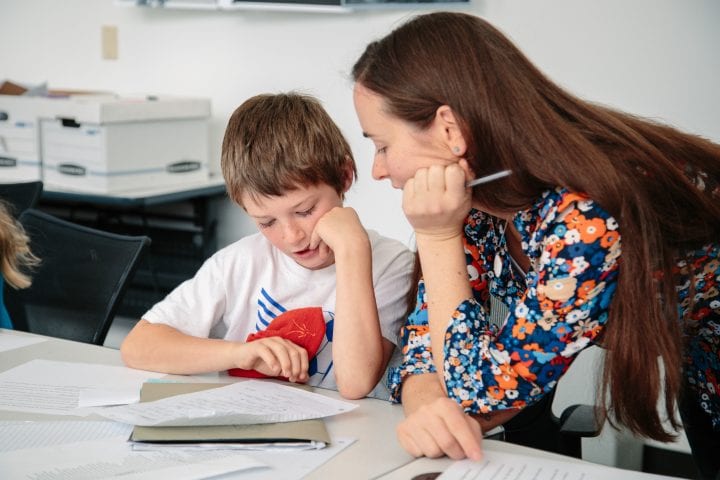
WITS Voices: Where the Place of Kindness Lives
February 3, 2018
By Jeanine Walker, WITS Writer-in-Residence
As a poet, I love to play with words. When writing or revising a poem, I can spend hours switching out a single word or phrase in an attempt to get the exact right one. Despite this, I believe a poet’s business is not words, exactly. A poet’s job is to express the ineffable, the feeling behind the words; the words, done right, are the vehicle that brings the reader to the sense the poet felt was so essential to express that she took the time and effort to say it in the condensed, impactful form of a poem.
Sometimes a poet gets lucky and happens upon that in the first draft. This is not uncommon, actually, with young writers, because children often naturally feel the poem behind the words with much more ease than we adults do. After the initial beginner’s luck—at the point when one becomes fully invested in the art of poetry—the ability to achieve the ineffable expression comes through practice.
I have been fortunate in my WITS teaching to work at the same schools three years in a row. At Alki Elementary in West Seattle, I finished my third residency with the fifth grade block (two fifth grade classes and one fourth and fifth grade mix) in November. One of the beautiful benefits of this return is that I have the opportunity to see the children grow as poets and to build off what they learned about this art form in the previous year.
I wondered, when a conversation with partner teachers at our initial planning meetings resulted in the decision that I would teach a lesson on poems of protest this year—so many students had, in 2017, expressed a curiosity about different ways to constructively resist an authority with which they take issue—if this would be too heavy a subject, too serious, and if I’d find any mentor texts suitable for fifth-graders. But it occurred to me almost as quickly that this was my third year of poetry with these students; they trusted me and I certainly trusted them, and I knew them to be a group of strong and hard-working young poets. That the teachers were entrusting me with this job, too, meant a lot—so I grew to the task.
I learned just how right-on the teachers were to suggest this. When I told the students what we’d be doing, the kids cheered. An initial list of causes they felt passionately about ranged from Black Lives Matter to feminism to the environment to having longer recess and lunch times. In all cases, their concerns were real and they were ready to write about them. We listened to Maya Angelou read “Caged Bird,” read Adrienne Rich’s “What Kind of Times Are These,” and Ilya Kaminsky’s “We Lived Happily During the War” out loud, and discussed all of them.
It wasn’t, in fact, a heavy discussion, but it was a serious one: we talked about the issues behind these metaphors, about the metaphors themselves and how these poets used form, imagery, mood and voice to capture the ineffable, that essence behind the words, and make an impact that might have the effect of persuading someone with the power to change things on a systemic level the same way that a march or a sit-in might.
One poet in this group is Hannah Schuh, now a fourth-grader at Alki and a student in Julie Calkins’ fourth and fifth grade class this year. My aim in sharing these poems from sequential years is two-fold: I want to at once demonstrate how a child’s poetry can grow year to year and to show that, if given the task of capturing through metaphor something that is difficult or even less poetic when said directly, a student of this age can do this. Hannah is wonderful and bright and has a knack for working with words—and I have a whole stack of poems from this group of students that shows that when it comes to getting at the feeling behind the poem, Hannah is one of many exceptional students who understand, through having practiced, how to use the words of poetry to get at the feeling behind it.
In second grade, Hannah wrote the poem below that employed imagination and the formula of a recipe to talk about teleportation. In third grade, Hannah went a little more deeply into her personal history to talk creatively about where she’s from: “I’m from the family that raised me so willingly” and “I’m from the paintings and art pieces my father made.” In fourth grade (as part of the fifth grade block), Hannah wrote “Where the Place of Kindness Lives,” her lovely protest poem.
Recipe for Teleportation
First you scoop in a handful of air.
Then you toss in some spoons full of fire.
You pour in some fun places.
Beat and stir the air, fire, and fun places.
Sprinkle in a dash of gravity.
Blend up a bit of the sky.
Crack up the end of a rock.
Mix up all the ingredients.
And now you are ready to serve.—Hannah Schuh, 2nd Grade
Where I’m From
I am from the old photos on the shelf.
I am from my old jewelry box filled with bracelets
and necklaces.
I am from the giant bush that my cousin and I
climb.
I am from the dandelions that turn yellow
in the spring.
I am from the old rose that was planted when
I was little.
I am from the timer on the oven beeping
loudly.
I am from the golden locket I found in a drawer.
I am from the war that my grandfather went
fighting in.
I’m from my family that raised me so willingly,
roof over my head, food on my plate, water in my glass.
I’m from the ocean, the fish swimming around
the seashells that sunk.
I’m from the paintings and art pieces my father
made. I’m from fall, summer, winter, and spring
clashing together to form one.—Hannah Schuh, 3rd Grade
Where the Place of Kindness Lives
When they took kindness away
it was only downhill from there.
There was a place
full of peace and love between us
but now it was gone.I would walk to where
peace and love had turned to shadows
hoping to find something there.
Hoping to find something other than
cold waves of wind.I hope to find one last piece
of hope and kindness deep in these dark shadows.
I will not speak of this place.I will not speak of where everything disappeared.
But do not be fooled
because this is not a poem
of hatred and disappearance.
This is a poem about kindness and love.—Hannah Schuh, 4th Grade
When I tell people I just meet that I teach poetry to elementary school students for a living, most respond with an enthusiastic, “That must be fun!” I often smile and say, “You have no idea.” Their poetry goes far beyond any “fun” thing someone who doesn’t know can imagine, and although it is deeply fun, teaching poetry to elementary school students is also a way to help them say what they want to say. And they have a lot to say.
Hannah was able to get to the feeling behind the words, and many of her classmates can, too, because they are practicing year after year and learning new ways to write. By the third year, this student is writing something sophisticated and meaningful in a way that goes beyond the self and talks more broadly about the current state of our world.
When I brought in poems that took a stand, I didn’t know what result to expect. It turned out to be a powerful one: reading these poems seemed to invite and allow students to take a stand themselves, a task they were more than ready for—made ready, I’m sure, by their excellent classroom teachers at Alki, their conscientious parents, and by their constant absorption of the feelings around them. Whatever we adults do to shield our kids from the current climate of division and unkindness, they seem to pick it up regardless. Poetry may be the perfect vehicle to express that, to resist it, and to imagine the future they have all the power to create. Practicing the art of poetry year after year puts students in just the right place to know which words to choose to get there.

Jeanine Walker is a poet who holds a Ph.D. in Creative Writing and Literature from the University of Houston. Her poems and reviews have appeared in Cimarron Review, Cream City Review, Gulf Coast, Narrative, PageBoy, and Web Conjunctions. She has performed at many venues around town and is the host of the popular reading series Cheap Wine & Poetry.